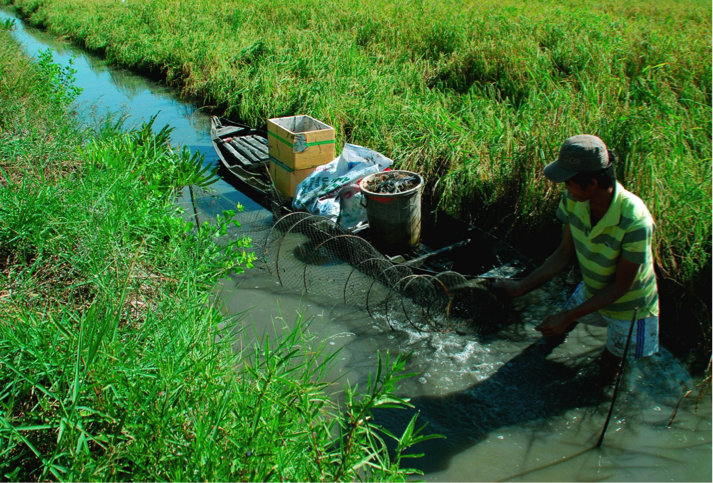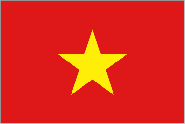CBA Viet Nam: Conservation & Sustainable Use of Drought and Salinity-Tolerant Rice Varieties in Phuoc Long Community
Project Overview
This Community-Based Adaptation project aims to help minimize vulnerability and strengthen local adaptive capacity to reduce the impacts of drought and saltwater intrusion in rice production at Phuoc Long Commune, Phuoc Long District, Bac Lieu Province, Viet Nam. The project’s first objective is to enhance local authorities’ and communities’ awareness and understanding of climate change impacts on socio-economic development. It will also build a model for applying technological advances in conservation and sustainable use of local rice varieties that are tolerant to droughts and salinity.
The key results of the project will enhance rice farmers’ capacity to cope with these effects. Their income will be secured and increased by 10-12%. Successful drought- and salinity-tolerant rice varieties will be promoted for wide application in the commune and other areas through the dissemination of the project technical documents provision of seeds.
* This project is part of Viet Nam's Community-Based Adaptation portfolio. *
Project Details
Phuoc Long commune of Phuoc Long district, Bac Liêu province, is a purely agricultural commune divided into nine (9) hamlets including 4,130 hectares of agricultural land. Rice cultivation is the primary income source. However, as rice cannot grow on the entire agricultural land area due to high salinity of the soil, the Phuoc Long’s model of production is characterized by an extensive culture system of giant tiger shrimp, crab and fish crops in addition to rice production.
The commune’s total population is 14,401 with 3,178 households, of which women account for 51.9%. Over half of inhabitants’ income derives from aquaculture (giant tiger shrimp, fish, crab and rice crops); the remaining 40% is earned from other jobs and services (paddy, vegetables, fruits, services). Another characteristic of the area is the numerous interlaced canals surrounding the commune and facilitating the transportation of passengers and commodities on waterways. However, these canals enable saltwater to flow far into the inner fields, causing harmful salinity intrusion. In addition, Phuoc Long’s agricultural activities are threatened by the impacts of drought, shortage of freshwater for plants, as well as fish and shrimp diseases, resulting in unstable income.
Nevertheless, while salinity intrusion is a crucial issue threatening rice production, some local rice varieties adapt well with salinity and yield. Therefore, to protect biodiversity and preserve sustainable cultivation systems in the coastal Mekong Delta, one of this project’s top priorities is the establishment of measures for conserving local drought and salinity-resistant rice, together with a strategy of integrated measures to develop and transfer the application to local farmers in a more effective manner.
The project’s main objective is to enhance the local community’s adaptive capacity to address the impacts of saltwater intrusion. On the one side, the project focuses on promoting local government authorities’ and community members’ awareness and understanding of climate change impacts and the advantages offered by local sustainable development. On the other side, the project contributes to conservation and sustainable use of local rice varieties, which are tolerant to droughts and salinity. This second part of the project takes place in three (3) villages of Phuoc Long commune while awareness raising activities will be conducted widely in the whole commune.
Key Results and Outputs
Objective 1. To promote the awareness and understanding of the local government authorities and inhabitants on the impacts of climate change on local sustainable development.
Enhance the awareness and understanding of related partners on the impacts of climate change and adaptation measures through leaflets, posters, and dialogues that reach a wide audience of stakeholders (Output 1.1).
Objective 2. Contribute to conservation and sustainable use of local rice varieties which are drought and salinity tolerant
Design demonstration models to evaluate the adaptability, productivity, quality and economic efficiency of 5 drought and salinity-resistant rice varieties using popular local cultivation structures such as seasonal rice crop –shrimp, seasonal rice crop – fisheries and Summer Autumn rice crop- seasonal crop (Output 2.1) Successfully restore 1-2 local rice droughts and salinity tolerant varieties, including Đốc Phụng, Một Bụi đỏ, Đốc Đỏ (Output 2.2).
Objective 3: Build an intensive cultivation model of drought and salinity-resistant rice varieties using combined cultivating techniques to reduce soil degradation due to droughts and salinity penetration.
Develop and test an intensive cultivation model of 2-3 drought and salinity-resistant rice varieties, ensuring community participation through 10 training workshops for 400 participants (Output 3.1), and the wide dissemination of technical documents through community meetings, conferences, and workshops (Output 3.2).
Reports and Publications
PIFs
Monitoring and Evaluation
The Vulnerability Reduction Assessment (VRA) will be measured at the planning stage of the project, at the mid-point, and at the end of project. Given that the VRA is qualitative and is based on the community perceptions, the first VRA was conducted to establish a baseline during the Project planning phase. A second VRA will be done at mid project after all the project activities to build the model has been completed. A final VRA will be done at the end of the project to assess the overall impact of the project on the community adaptive capacity.
The VRA questions that will be used are as follows:
- Rate the impact of droughts, salt water intrusion, and land degradation on your livelihood
- Rate your ability to cope with the negative impacts of droughts, salt water intrusion, and land degradation
- Rate the impact on your livelihood if droughts, salt water intrusion, and land degradation doubles
- Rate how effectively you would be able to cope with the doubling of droughts, salt water intrusion, and land degradation
- Rate how effective you think this project will be in reducing your risks from increasing droughts, salt water intrusion, and land degradation.
- Rate your confidence that the project will continue to reduce droughts, salt water intrusion, and land degradation risks after the project ends.
- Rate your own ability to cope with increasing droughts, salt water intrusion, and land degradation and other climate changes after this project ends.




